|
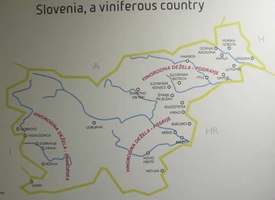 Slovenia is divided into 3 wine zones further sub-divided into 9 sub zones. To the north east is Podravje (land of Drava-named after the Drava River- a tributary of Danube and adjoining Austrian border) further sub-divided into Prekmuje and Štajerska Slovenija (Slovenian Styria). In the centre (southeast of Ljubljana) is the lesser important wine zone of Posavje (Land of the Sava-another tributary of Danube) further divided into Bela Krajina, Dolenzska and Bizelsko Sremič. The western zone adjoining Italy is Primorska (The Coast) divided into Koper, Kras, ipava Valley and Goriška Brda. I managed to visit 10 wineries in Štajerska Slovenija, Vipava Valley and Goriška Brda and tasted wines at Slovenia is divided into 3 wine zones further sub-divided into 9 sub zones. To the north east is Podravje (land of Drava-named after the Drava River- a tributary of Danube and adjoining Austrian border) further sub-divided into Prekmuje and Štajerska Slovenija (Slovenian Styria). In the centre (southeast of Ljubljana) is the lesser important wine zone of Posavje (Land of the Sava-another tributary of Danube) further divided into Bela Krajina, Dolenzska and Bizelsko Sremič. The western zone adjoining Italy is Primorska (The Coast) divided into Koper, Kras, ipava Valley and Goriška Brda. I managed to visit 10 wineries in Štajerska Slovenija, Vipava Valley and Goriška Brda and tasted wines at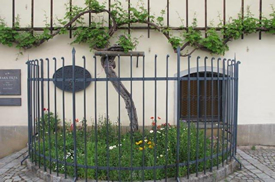 several restaurants, wine bars and places including the House of Old Vine in Maribor, where the 400-year vine still giving fruit and growing next to the Drava River across, has been declared as world’s oldest fruit yielding vine by the Guinness World of Records. several restaurants, wine bars and places including the House of Old Vine in Maribor, where the 400-year vine still giving fruit and growing next to the Drava River across, has been declared as world’s oldest fruit yielding vine by the Guinness World of Records.
(Tips in basic pronunciation: All letters are pronounced as in English-even when there is no vowel. For instance Brda is Bu-r-da. Š is ‘sh’ and Č is ‘ch’, J is something like i or yy sound. So Štajerska is pronounced as Sh-ta-ye-r-ska and Sremič is Sre-mi-ch. It took me a couple of days to get the handle. It’s fairly easy now. Croatia has similar pronunciation).
1. STEYER
www.steyer.si
Contact: Danilo Steyer
steyer.vina@siol.net
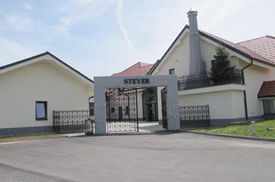 The winery located in the village of Plitvica in Štajerska Slovenija (Slovenian Styria) in the wine region of Podravje, is owned by Danilo Steyer, -the third generation owner and winemaker and considered the king of Gewürztraminer in Styria. Starting the grape growing in 1934 the Steyer family has risen to a point where a world class modern winery has been constructed with the aid of EU funds. It was inaugurated two days after I visited them. The winery located in the village of Plitvica in Štajerska Slovenija (Slovenian Styria) in the wine region of Podravje, is owned by Danilo Steyer, -the third generation owner and winemaker and considered the king of Gewürztraminer in Styria. Starting the grape growing in 1934 the Steyer family has risen to a point where a world class modern winery has been constructed with the aid of EU funds. It was inaugurated two days after I visited them.
I had met Danilo at Taste Mumbai- a wine show about 5 years back and had loved his wines. Also present at the Show was Larisa Zibrik who used to work with Radgoneske Gorice, the largest sparkling wine producer and is now his export agent (He is very keen and capable of exporting his wines to India). I was the first international wine journalist to visit the winery.
The winery is a member of Family Estate Slovenia, an Association of family owned wineries and considers itself as the House of Gewürztraminer. He owns 16 hA land and produces 100-120,000 bottles a year, buying some grapes from outside. Like prevalent elsewhere in the zone, the area has continental climate. He uses screwcaps for his wines. He exports to France, UK, Sweden and Japan besides several Central European nations. His wines are listed in luxury hotels like Ritz Carlton.
I tasted 12 wines including Sauvignon Blanc, Chardonnay, Riesling, Welshriesling, Ranina Steyer (made from a delicious local grape) and of course the House speciality the 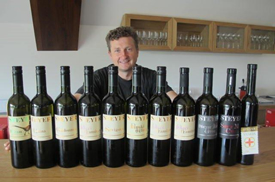 Gewürztraminer. I found all the wines delicious, with Gewurztraminer outstanding at 93/100, Riesling 2013 at 90/100, a semi sweet Gewuertz (28 gms/li res sugar) delectable at 92/100. But the wines I found excellent were Sauvignon Blanc with guava flavour (95/100) and a sweet Gewuertz with 250 gms/lt sugar with racy acidity balancing the sugar at 95/100, the two sure winners. Gewürztraminer. I found all the wines delicious, with Gewurztraminer outstanding at 93/100, Riesling 2013 at 90/100, a semi sweet Gewuertz (28 gms/li res sugar) delectable at 92/100. But the wines I found excellent were Sauvignon Blanc with guava flavour (95/100) and a sweet Gewuertz with 250 gms/lt sugar with racy acidity balancing the sugar at 95/100, the two sure winners.
Apple of the eye for the Steyer family is the Vaneja sweet wine that is named after his daughter and made every 4 years. Reason? She was born on 29th February 2000, in the leap year. The Gewürztraminer from previous harvest is cold stored and fermented on 29th February every time, starting with 2004. Full of honey, lychee and tropical flavours the wine is truly an elixir. It may be a bit expensive at €50 a half bottle but considering only 1500 bottles are produced every four years, it’s a collectors’ wine.
1. JOANNES Protner
www.jannes.si
vini@joannes.si
Contact Person: Bo tjan Protner tjan Protner
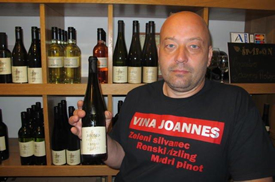 I met Protner in Reims, Champagne where I had gone to attend IWINETC- an international conference on wine tourism, when I tasted a few bottles he had brought with him. Iwasreallyimpressed with the wines-especially Riesling and I decided to visit him when I went to Slovenia. I met Protner in Reims, Champagne where I had gone to attend IWINETC- an international conference on wine tourism, when I tasted a few bottles he had brought with him. Iwasreallyimpressed with the wines-especially Riesling and I decided to visit him when I went to Slovenia.
He has a boutique winery with 30,000 bottles production out of which 5000 are the lighter and cheaper 1 liter bottles (selling for €2 a bottle). This may not appear significant to an outsider but the passionate winemaker is always on his toes, experimenting with grapes, soil, blending or processes to make his wine unique and better.
Protner Joannes estate expands over nine hectares of vineyards, of which three are located on the steep south side of Šempeter Hills. The vineyards are between 2-40 years old. Although he is a known Riesling specialist, he has a wide range - Zeleni Silvanec (Gruener Silvaner), Renski Riesling , the aromatic Yellow Muscat, full bodied Chardonnay, grassy and aromatic Sauvignon, light rose – Pinot Gris and Pinot Noir.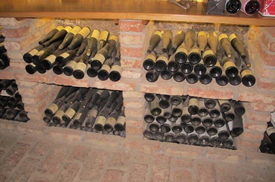 In the new vineyard he is now cultivating Šipon (Furmint) and Pinot Blanc. In the new vineyard he is now cultivating Šipon (Furmint) and Pinot Blanc.
I tasted a total of 16 wines- Sauvignon Blanc, Rumeni Muskatter, Muscat, Renski Rizling (Rheine Riesling), several dry and off-dry Rieslings and sweet Rieslings. He is also constantly experimenting with Pinot Noir a couple of which were also poured. Muscat is the second most important grape for him. Although some of his wines would be a perfect match for the spicy Indian food, he would find dealing with India extremely difficult and costly because of the small production. I particularly loved his dry Riesling 2007 which was elegant but was also shocked to learn that he sells it to restaurants at €6 and they sell it at €50! And we blame our hotels charging only 5-6 times more!
Sauvignon Blanc 2014 was dry but full on the palate, fruity, crisp with racy acidity and very clean though a bit weak at the back end. Non Ultra is a blend in equal proportion of Sauvignon and Welshriesling that was dry to semi dry and with high acidity in 2014 but sweeter. Renski Rizling 2013 was another beauty in which he uses a small percentage (up to 15%) of wine from the previous vintage which also adds the petrol flavour, he says.
1. The House of Wine Doppler
http://www.doppler.si/?lng=uk
Contact: Mihaela Krsnik Kopše
info@doppler.si
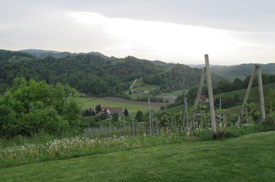 Much before you start going into the winery which is totally underground, one is overawed by the beauty of the vineyards and the landscape around the winery owned by the third generation entrepreneur Mihaela Krsnik Kopše. Šentilj hills on one side and beautiful Pesica valley on the other side make you feel like singing and dancing on the terrace where she welcomed us with a glass of sparkling wine. Much before you start going into the winery which is totally underground, one is overawed by the beauty of the vineyards and the landscape around the winery owned by the third generation entrepreneur Mihaela Krsnik Kopše. Šentilj hills on one side and beautiful Pesica valley on the other side make you feel like singing and dancing on the terrace where she welcomed us with a glass of sparkling wine.
Perhaps, one day it will be possible to dance as she plans to open a deluxe boutique spa resort when the family can garner funds. She does realise she is sitting on a goldmine. The 360° view from the property is simply mesmerising. With her vision of transporting visitors from Maribor, she will have luxury tourists eating out of her plate-certainly drinking out of her (wine) bottles!
The vineyards and the winery are located at 380 meters and the winery is 7m deep under the ground. 50,000-60,000 litres of wine translating to 6,000 cases is sold annually with 60% being sold in Slovenia and the balance is exported to France, Germany, Austria etc. The winery is popular because of its modern construction and hygienic conditions and sells about 30% at the cellar door. This could be more since across the border in Austria some wineries sell as high as 70% at the cellar door!’ she says.
No irrigation is done at the vineyards. ‘If we do it once, we will have to do it, always’, she says. 90% of her wines are white -mainly Riesling Italico, Sauvignon Blanc, Chardonnay, Traminer, Moscato, Silvaner and Riesling. She also makes the red blend with Zweigelt . The 3rd generation family owner says the winery was started by her grandfather and then carried on by her 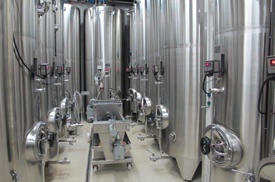 mother whom I met briefly at the winery. Her husband helps are also. mother whom I met briefly at the winery. Her husband helps are also.
Two thirds of the grapes are grown near this new winery while a third are still being cultivated near her house near Maribor which is about 30 minutes away. She uses her own grapes except for a little quantity of reds and chardonnay for sparkling wine.
Out of 10 wines tasted Sauvignon Blanc of 2014 and 2013 were outstanding with ’14 (90/100) being slightly more fruity but ’13 was more complex, elegant and less sharp (91/100). Šipon (Furmint) was a very interesting wine– crisp, clean, fruit and citrus ( 89/100). She owns 1 hA of this vine and say they have to work with hands totally as the slopes are very steep. This wine was made with reductive method.
She has named the top wine as 360 to highlight the view at the top of the winery and makes it in the best year-there was none in 2014. My favourite was the EFFEKT Rose- a cuvee of the Blaufränkisch and Zweigelt-made with short maceration of 2 hours and from free running juice. Well perfumed, good balance and a great company for Indian summer. Another interesting wine was Muscat Ottonel.
There was an interesting Sauvignon Blanc made from 40 year old vine and with 20 months in Barrel and made with a reductive method-strictly a food wine as it was quite oaky by itself.
1. VALD HUBER
www.valdhuber.si
valdhuber@siol.net
Contact: Bogomir ValdHuber
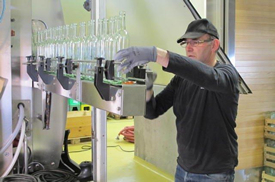 Located in a small hamlet of Svečin, Valdhuber produces elegant white wines and a limited quantity of red wines, primarily Pinot Noir. The story of this farm goes back to 1913 and now thecurrent owners Bogomir (Mirč) Valdhuber and his wife look after the winery with a holding of 7 hA of vineyard. Located in a small hamlet of Svečin, Valdhuber produces elegant white wines and a limited quantity of red wines, primarily Pinot Noir. The story of this farm goes back to 1913 and now thecurrent owners Bogomir (Mirč) Valdhuber and his wife look after the winery with a holding of 7 hA of vineyard.
The Valdhubers have built a fabulous 3-apartment facility each with kitchen and 2 huge rooms, very tastefully done up. The view from the rooms opening into a balcony is simply breathtaking. The wine tasting room and the shop would put many winery shops in Western Europe to shame because of originality and functionality in design. No wonder 30% of the sale out of 40-50,000 liters produced, is at the cellar door. 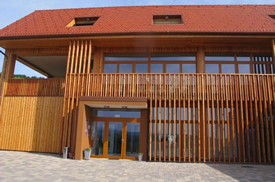 Bogomir does export to the adjoining Austria. Bogomir does export to the adjoining Austria.
At the wine tasting at dinner I tasted 6 wines -Beli Pinot 2014 was an excellent white wine-an example of how their wines match with food. It paired beautifully with the potato soup, bear garlic (green leaves) and some vegetables. The wine was rated at 89/100 but with soup it shot up to 95/100.
Bogomir is also a hands-on person. He was busy bottling when I visited the winery early morning and found him bottling. The winery along with over a dozen others, rents the portable bottling plant through this Association, making it financially a better option.
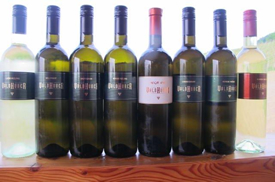 This is an excellent place to spend a couple of days, visiting the winery and tasting delicious food cooked by his wife. And don’t worry about the internet; it may seem to be far from civilisation but you get Wi-Fi without any problem or costing extra! This is an excellent place to spend a couple of days, visiting the winery and tasting delicious food cooked by his wife. And don’t worry about the internet; it may seem to be far from civilisation but you get Wi-Fi without any problem or costing extra!
After bidding the couple goodbye, I was driven towards Vipava Valley in the West. Details of the visits will be covered in future editions.
Subhash Arora
I am grateful to my Slovenian friends, Bruno Gaberšek and his colleague Nina Levičnik for organising the trip and his accompanying me to these wineries
|